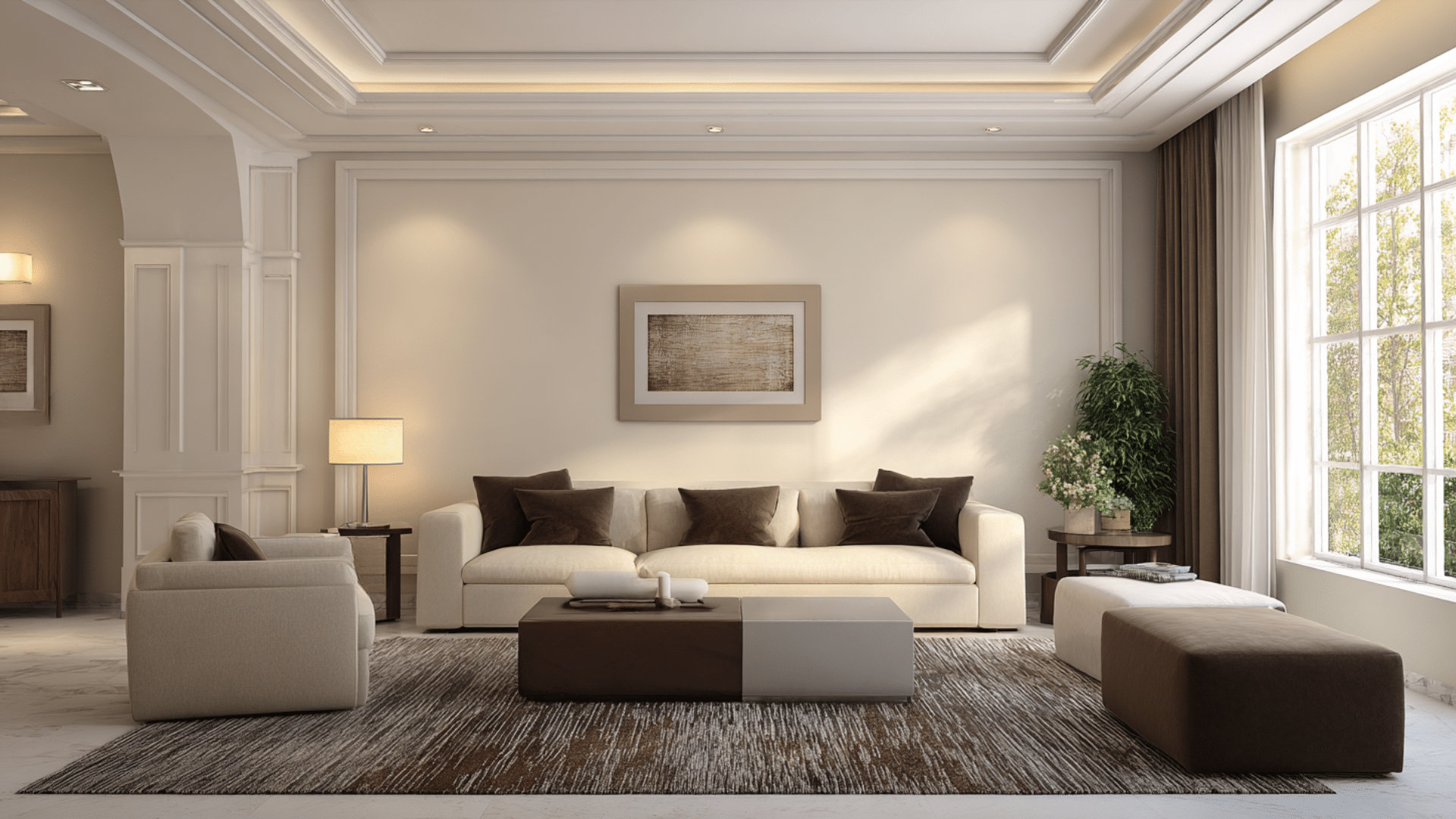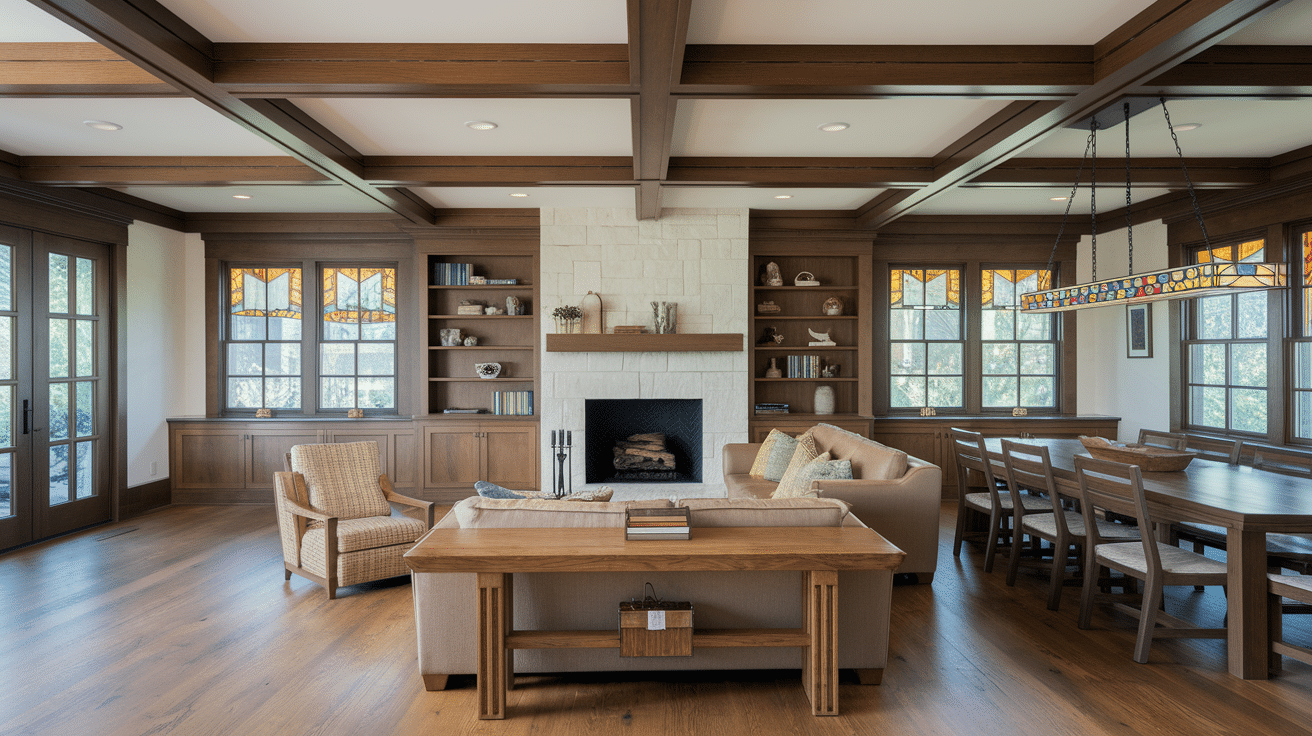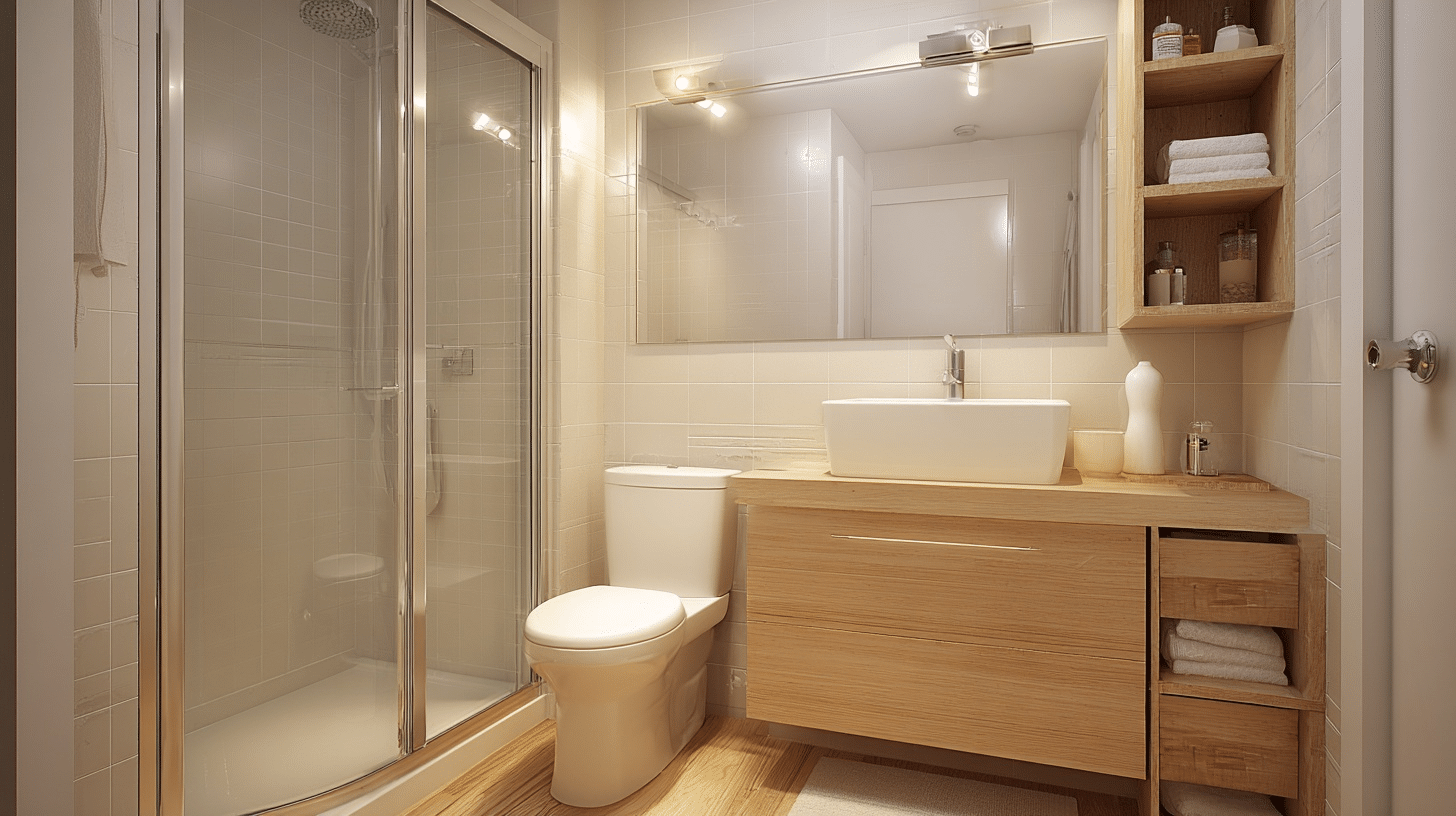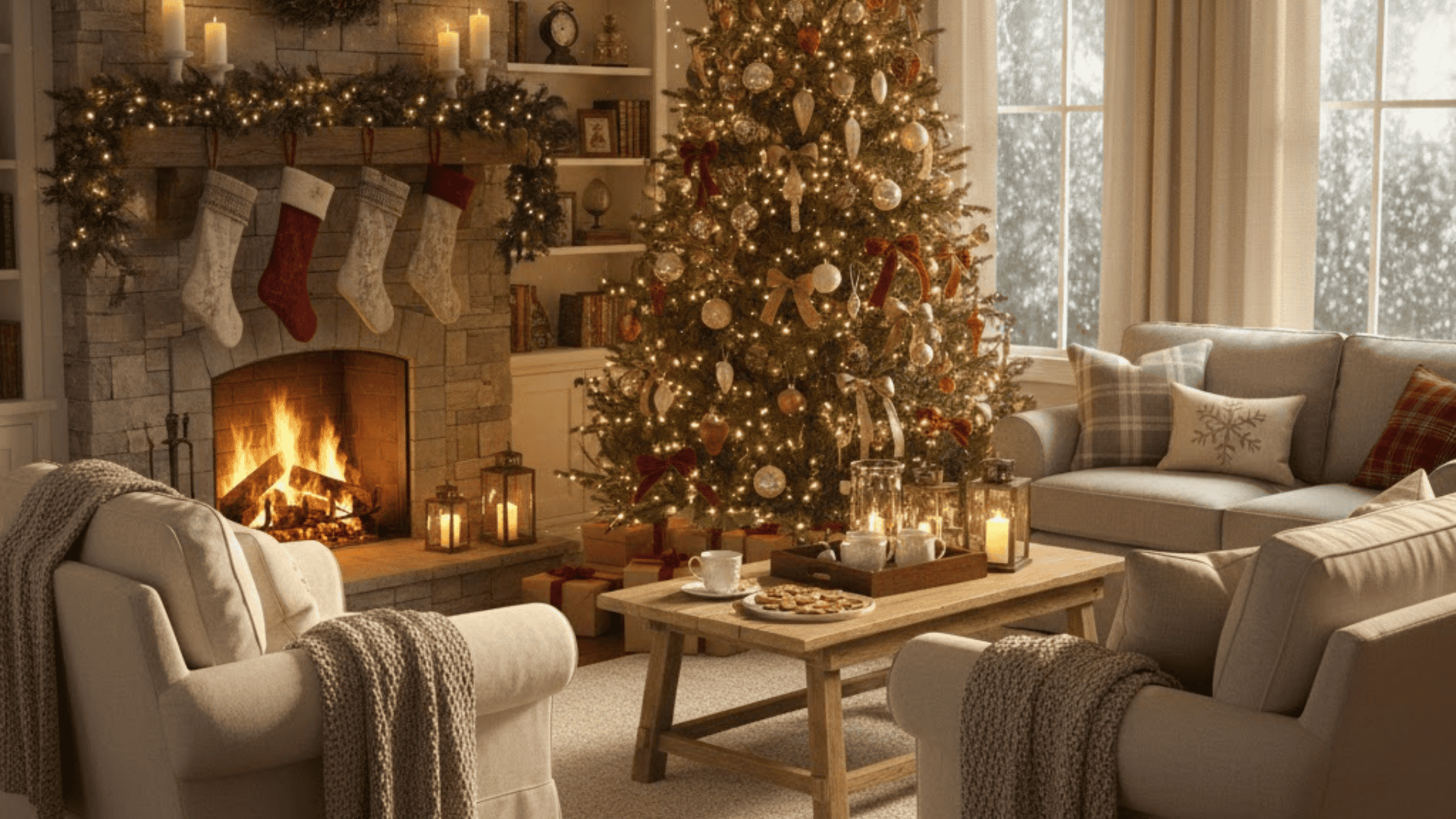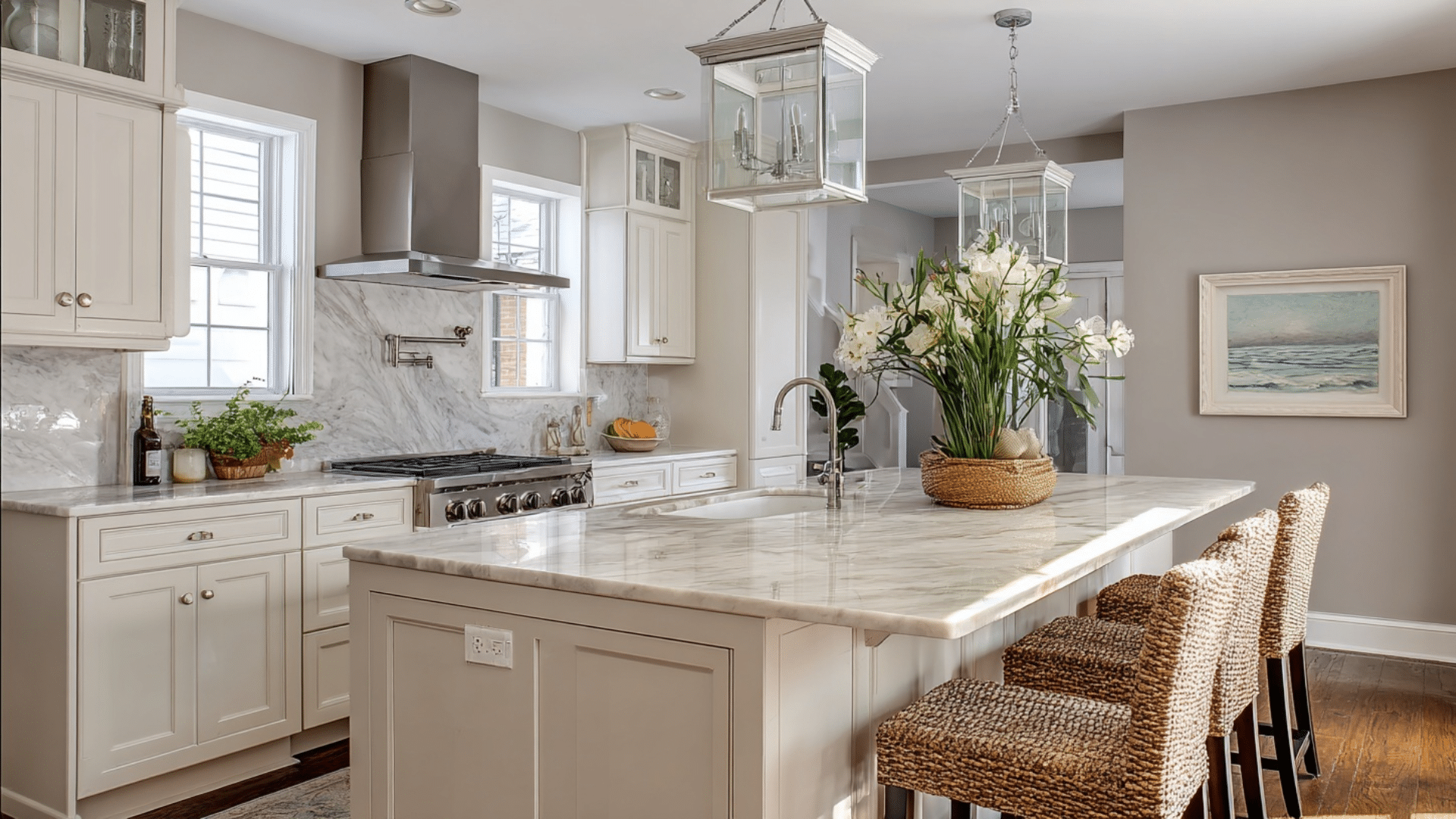Does your living room feel stuck, heavy, or just not quite right? Many people sense something is off, but can’t pinpoint the problem.
Feng shui offers answers that go beyond typical interior design advice. This ancient practice examines how energy flows through spaces and affects everyone inside.
When applied correctly, it changes not just how a room looks but how it feels.
The steps and tips ahead will guide you through each practical change that will help you add feng shui to your living room for better energy in your home.
The Elements of Feng Shui
Feng shui works with five natural elements that create balance in any space.
These elements help make better choices about colors, materials, and decor. Each element carries specific energy and connects to different areas of life.
Wood
Wood represents growth, vitality, and new beginnings in feng shui practice.
This element brings fresh energy into the living room and supports creativity. It connects to family relationships and health.
What you can add:
- Live plants in ceramic or terra cotta pots
- Wooden furniture pieces like coffee tables or bookshelves
- Green and brown color accents in pillows or artwork
- Bamboo accessories or vertical wall decor
Fire
Fire brings passion, enthusiasm, and high energy to living spaces.
Fire energy changes spaces and motivates people. It connects to recognition and fame in feng shui philosophy.
Too much fire can clutter, so balance matters when adding these items to the room.
What you can add:
- Candles in safe holders on side tables
- Red, orange, or purple accent pieces
- Triangle or pyramid-shaped decor items
- Natural sunlight through clean windows
Earth
Earth provides stability, grounding, and nourishment in the living room.
This element creates a sense of security and supports relationships. Earth energy helps people feel centered and calm. It connects to health and romantic partnerships.
What you can add:
- Square or rectangular ceramic vases
- Yellow, beige, or sandy-toned accessories
- Stone or clay decorative objects
- Crystals like rose quartz or clear quartz
Metal
Metal adds clarity, focus, and precision to living spaces.
This element supports logical thinking and helps organize thoughts. Metal energy brings structure and efficiency to rooms. This element creates boundaries and definition.
What you can add:
- Metal picture frames or wall art
- White, gray, or metallic color schemes
- Circular or oval-shaped mirrors
- Brass, copper, or steel decorative items
Water
Water represents flow, abundance, and ease in feng shui principles.
This element brings calm energy and supports wisdom.
Water connects to career and life path. It encourages things to move smoothly without resistance. Rooms with water energy feel peaceful and reflective.
What you can add:
- Small fountains with gently flowing water
- Blue or black accent colors in throws
- Mirrors that reflect light throughout space
- Curved, wavy shapes in furniture or art
Adding Feng Shui to your Living Room
Applying feng shui principles involves specific actions that alter the flow of energy through the living room.
These changes make noticeable differences in how the space feels.
1. Clear Clutter and Remove Broken Items
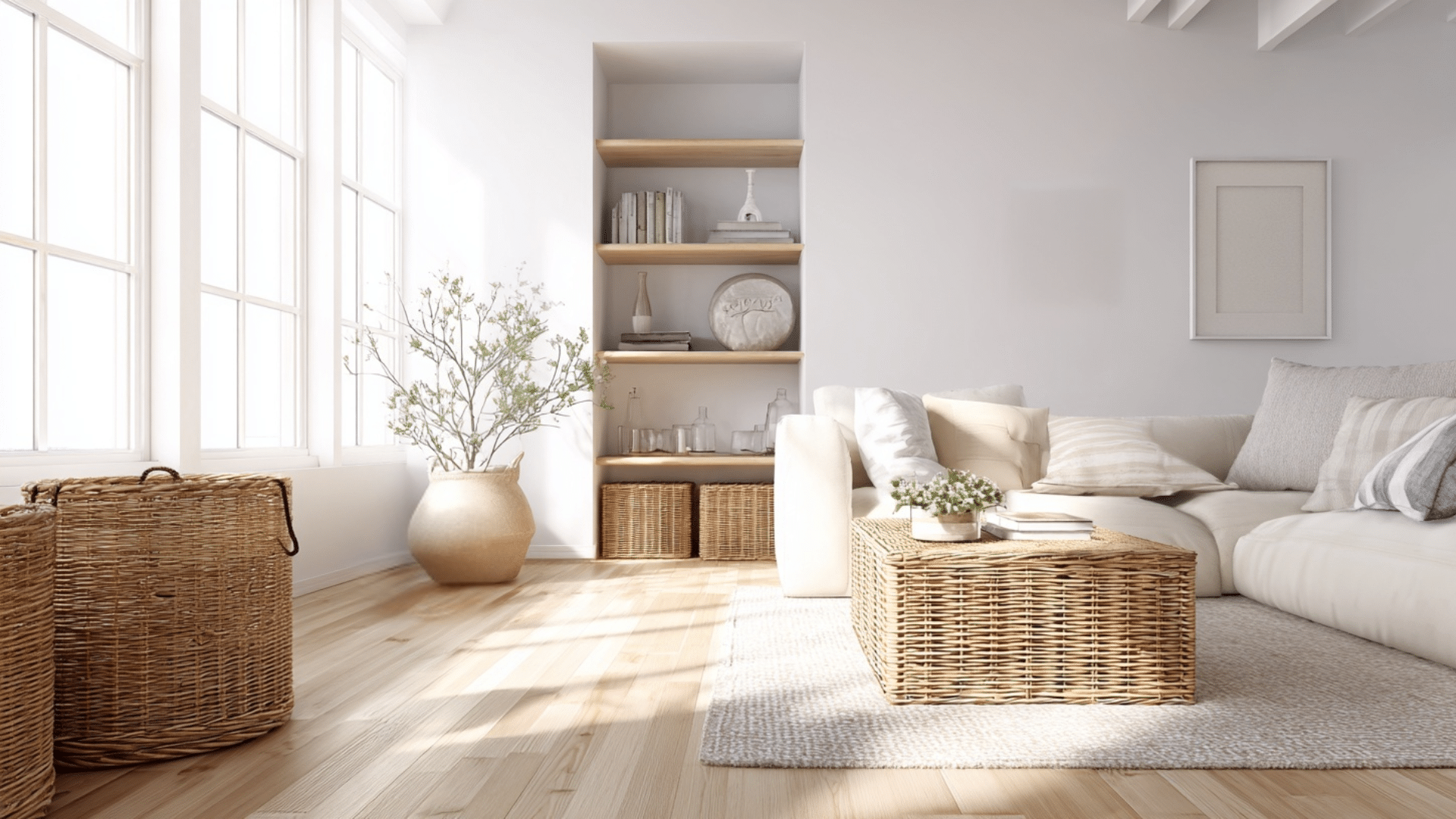
Clutter blocks energy flow and creates cluttered areas in the living room.
Items piled in corners or scattered across surfaces prevent positive energy from circulating freely.
Broken objects carry negative energy and should be left in the home immediately. A clean, open space allows fresh energy to enter and move naturally throughout the room.
2. Position Furniture in Command Position
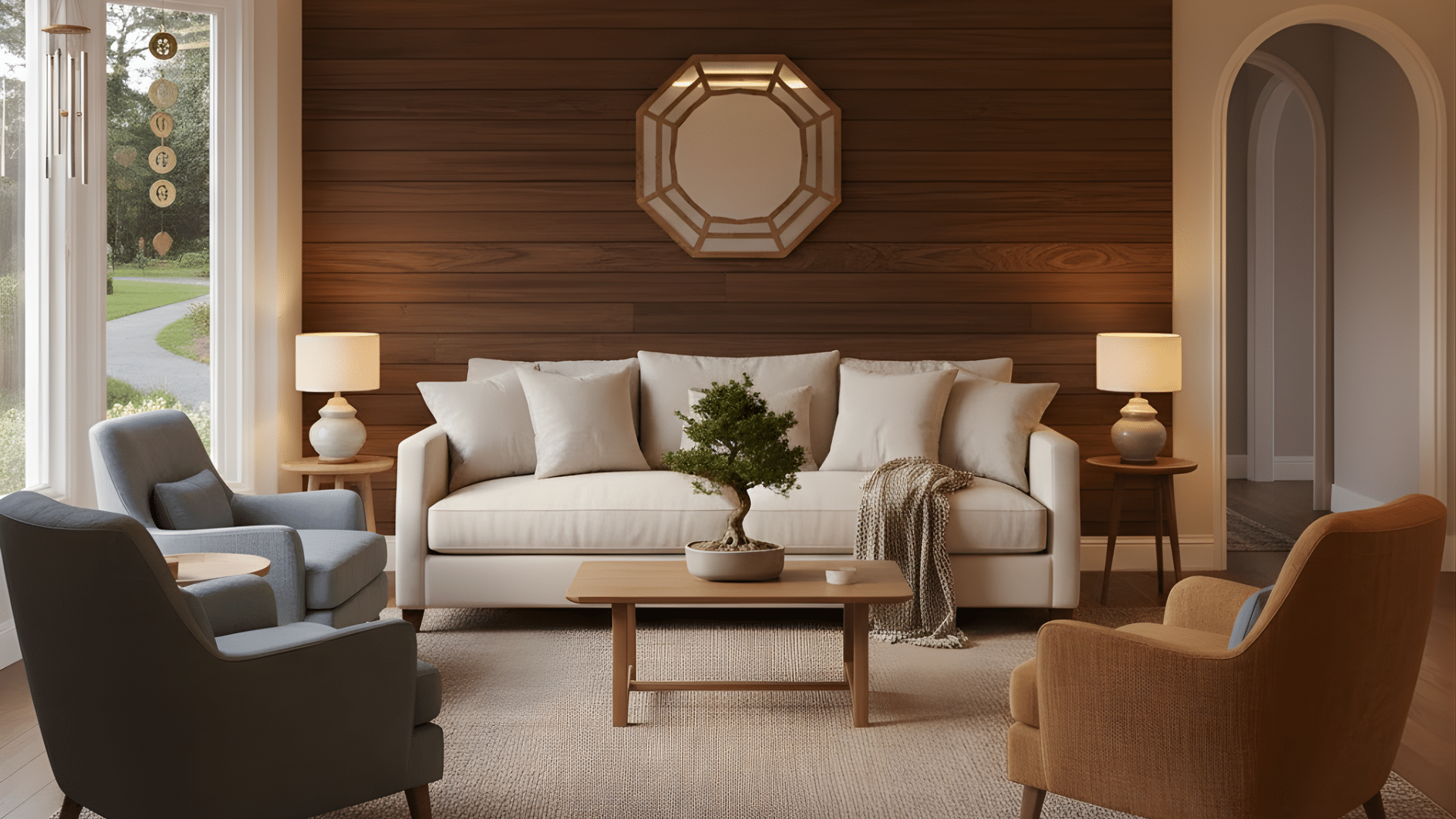
The main seating should face the room’s entrance without directly aligning with the door. This placement gives occupants a clear view of who enters while feeling secure and grounded.
The sofa needs a solid wall behind it for support and protection. Chairs should allow people to see doorways and windows
3. Improve Lighting Throughout the Space
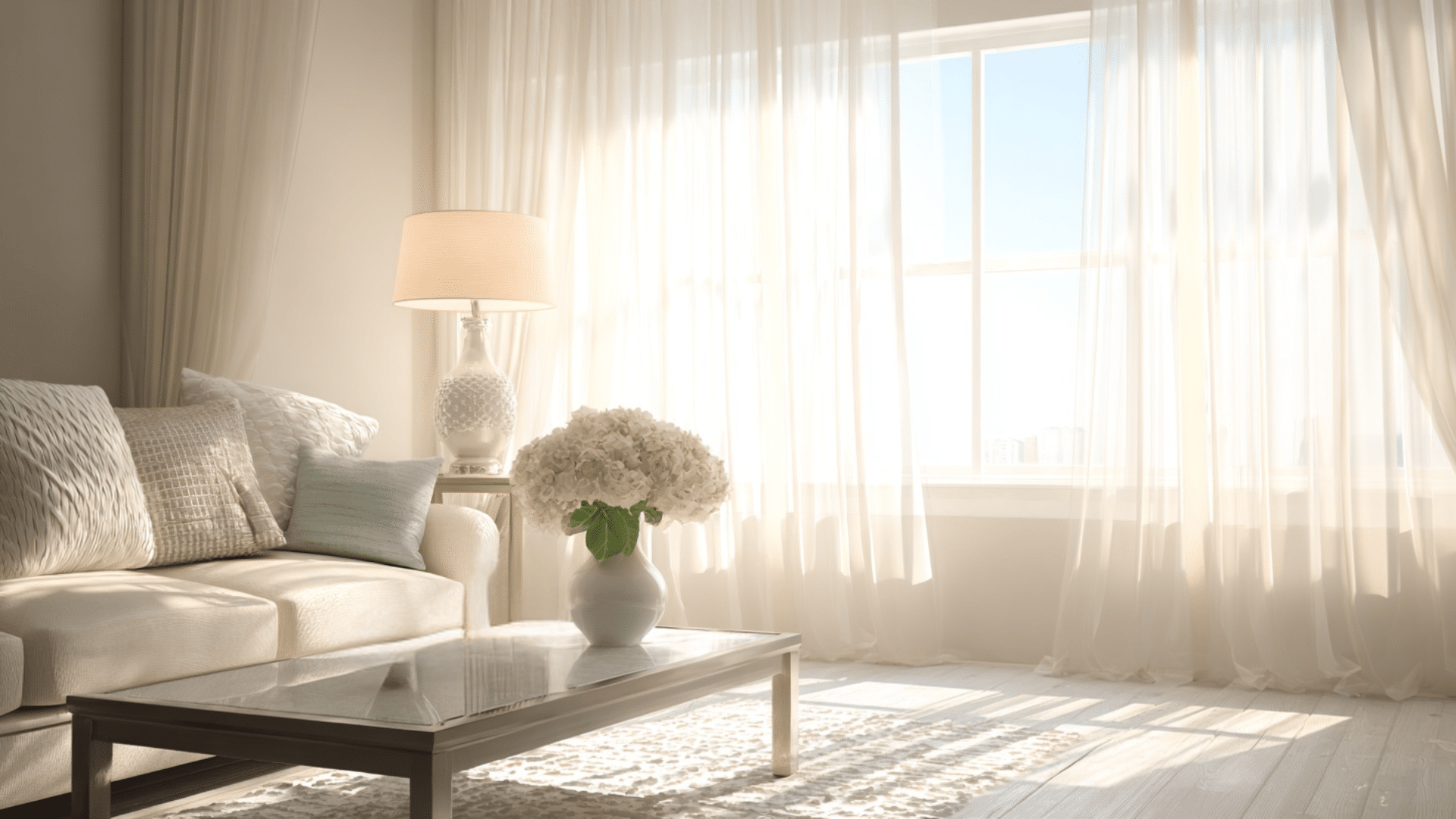
Good lighting represents the fire element and brings active, positive energy into the room. Dark corners collect stagnant energy and need attention.
Add lamps at different heights to create layers of light. Natural sunlight should enter freely through clean windows.
4. Use Mirrors Strategically
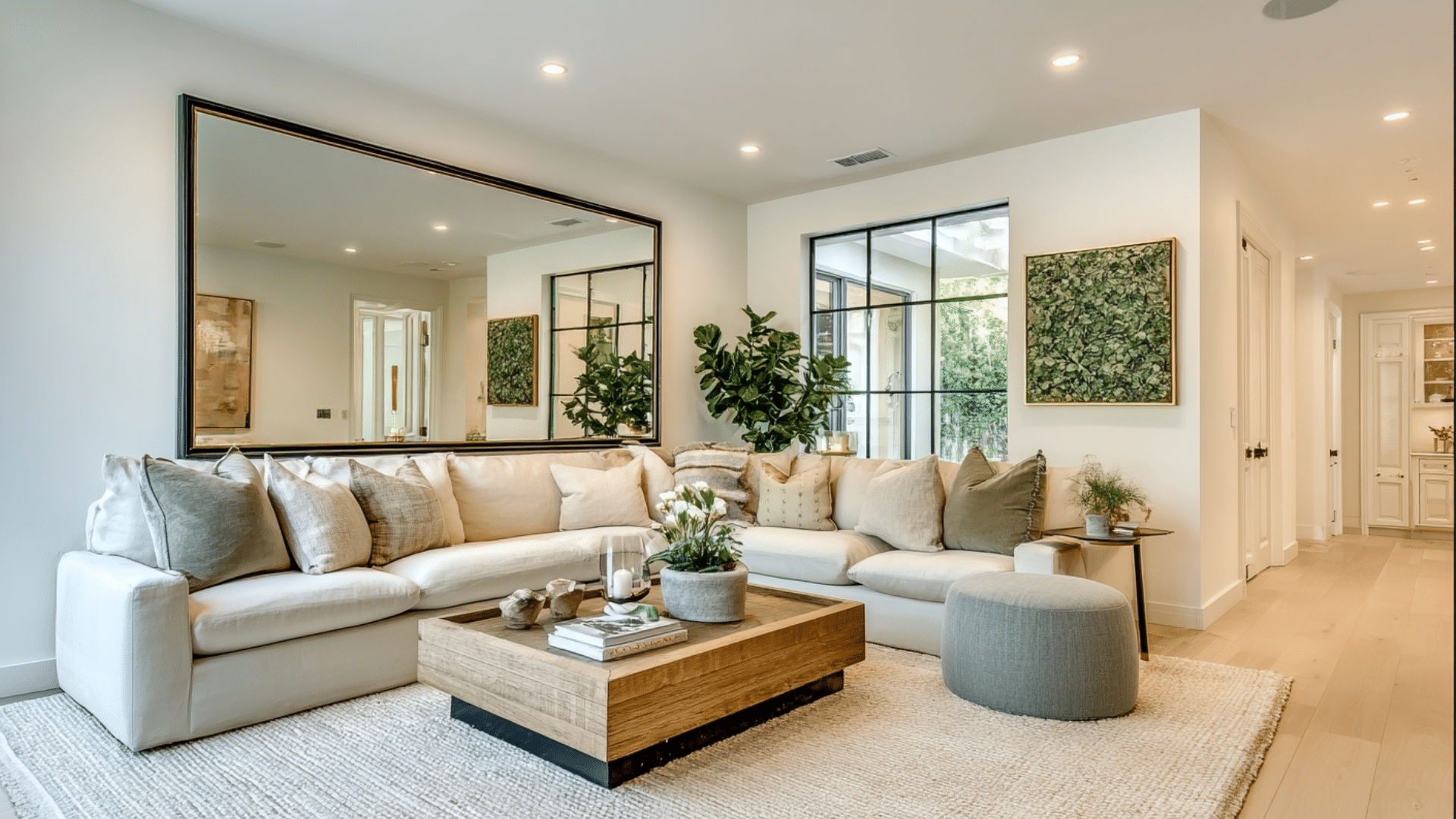
Mirrors expand space visually and reflect light to brighten darker areas of the room.
Place mirrors where they reflect beautiful views or pleasant scenes.
Never position mirrors directly facing the main entrance or reflecting clutter. Mirrors should reflect something positive, like plants or artwork.
5. Add Living Plants for Fresh Energy

Living plants bring the wood element and a life force into the living room naturally. Choose healthy plants with rounded leaves rather than sharp, pointed ones.
Avoid dried or fake plants as they represent dead energy.
6. Choose Colors That Support Your Goals

Colors affect mood and energy in powerful ways that influence daily life significantly.
Warm colors like red and orange increase activity and social interaction among guests.
Cool colors like blue and green promote relaxation and peaceful conversations. Earth tones create stability and grounding in busy households.
7. Remove or Cover Electronics When Not in Use
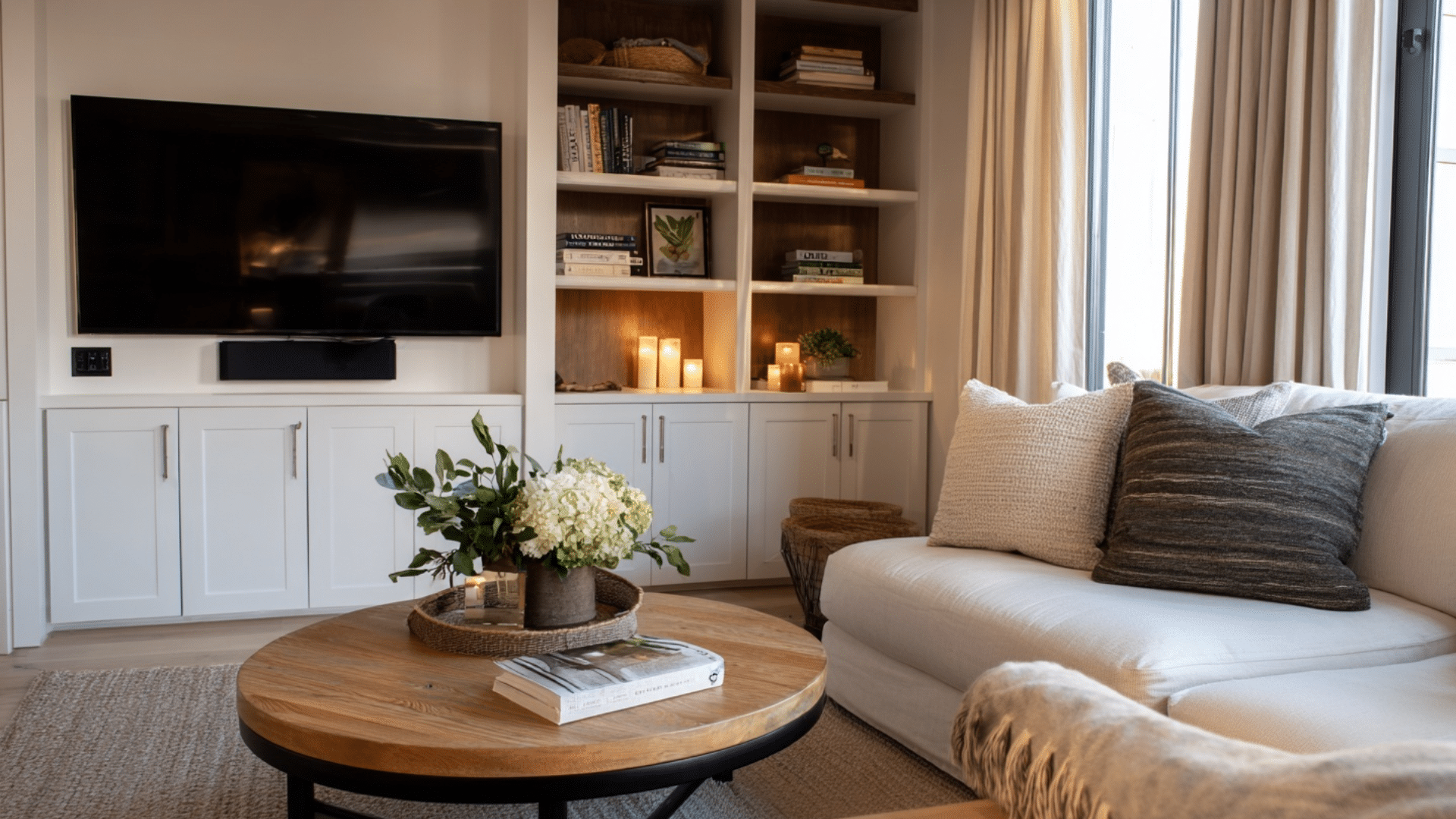
Electronics emit electromagnetic fields that disturb natural energy flow in living spaces.
Televisions, computers, and gaming systems create active yang energy that can clutter.
Keep charging cables organized and hidden from view. Create tech-free zones where people can truly relax and connect without digital distractions nearby.
8. Display Meaningful Art and Decor Only
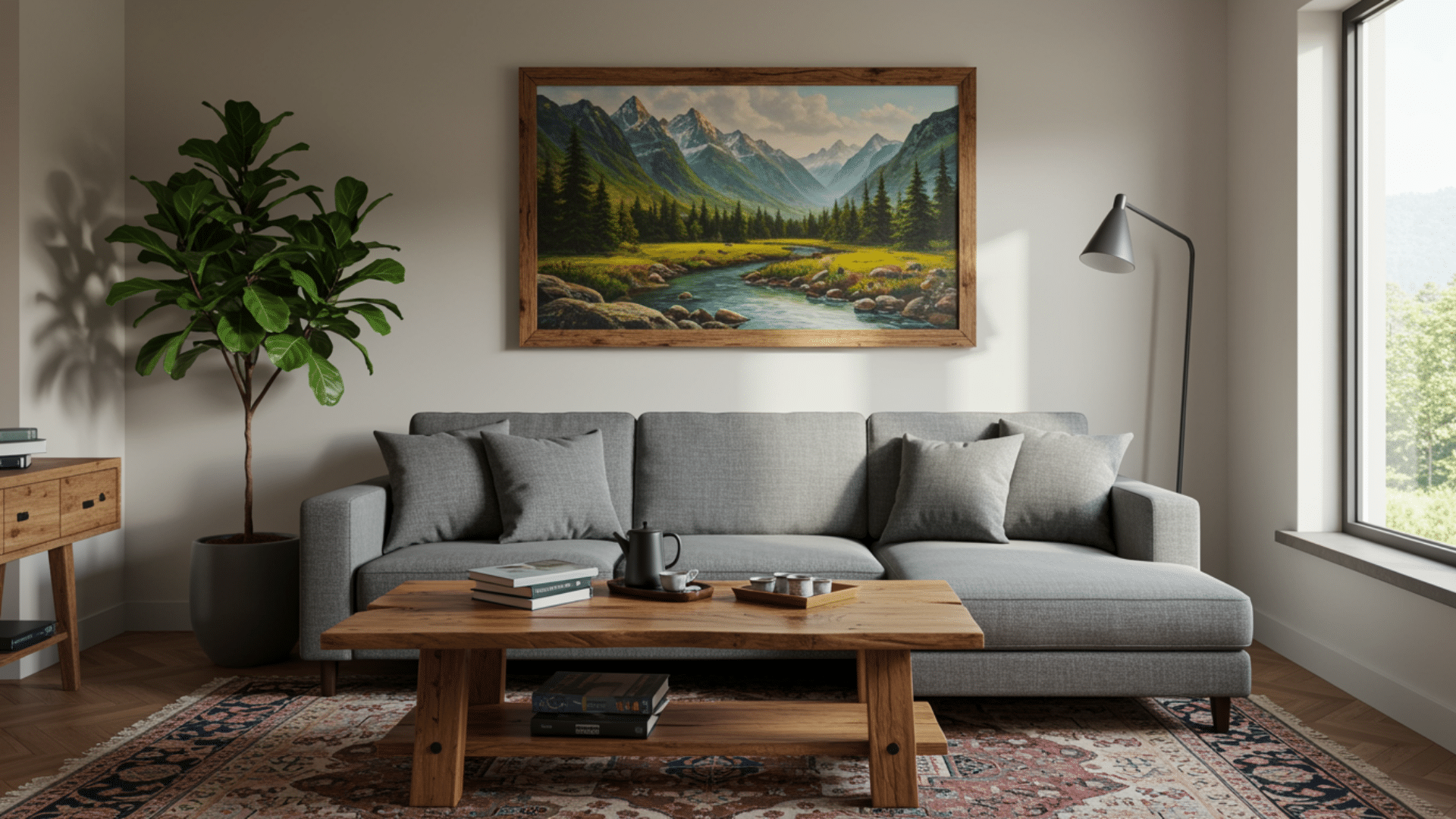
Every item in the living room should serve a purpose or bring joy.
Remove decor that carries negative memories or feels uncomfortable to view.
Images of water flowing toward the room bring abundance and opportunity. Avoid pictures showing loneliness, conflict, or sad themes that lower energy and dampen moods unnecessarily.
9. Keep Pathways Clear and Open

Energy needs clear paths to move freely from one area to another. Furniture should not block natural walking routes through the living room.
Leave space around all pieces so people can move comfortably without squeezing past obstacles.
Dos and Don’ts
These dos and don’ts provide quick reference points for making better decisions.
| Dos | Don’ts |
|---|---|
| Position the sofa against a solid wall for support and stability | Place the sofa directly in line with the main entrance door |
| Keep the living room clean, organized, and free of clutter | Allow broken items, dead plants, or unused objects to accumulate |
| Use soft, rounded furniture edges to promote smooth energy flow | Choose furniture with sharp corners pointing at seating areas |
| Display artwork and decor that brings joy and positive emotions | Hang pictures depicting loneliness, conflict, or negative scenes |
| Balance all five elements through colors, shapes, and materials | Let one element dominate the space and create an energy imbalance |
Mistakes that are Messing with Your Feng Shui Living Room Plans
Even well-intentioned people make feng shui errors that disrupt energy flow in their living rooms. Recognizing these common mistakes helps correct problems quickly.
1. Blocking the Main Entrance with Furniture
Placing large furniture pieces directly in front of the entrance door stops energy from entering the room.
The blocked entry creates immediate resistance and makes guests feel unwelcome before they even step inside the space.
2. Hanging Mirrors That Reflect the Front Door
Mirrors positioned to reflect the entrance door push positive energy right back out of the home. This placement prevents good opportunities and beneficial energy from staying in the living room where it belongs.
3. Positioning the Sofa Under a Window
Seating placed under windows lacks proper support and leaves occupants feeling exposed and vulnerable.
Windows behind seating create unstable energy and prevent people from feeling fully relaxed while sitting in that spot.
4. Using Too Many Sharp, Pointed Objects
Furniture with sharp corners, spiky plants, or pointed decor items creates cutting energy called “poison arrows.”
These sharp elements direct negative energy toward seating areas where people spend time and should feel comfortable.
5. Keeping Dead or Dying Plants in the Room
Wilted plants, dried flowers, or dead arrangements represent declining energy and decay in feng shui practice.
These items actively drain positive energy from the space and should be removed immediately to restore good flow.
6. Creating a Cluttered Coffee Table Surface
Coffee tables piled with magazines, remotes, and random items create visual chaos and block energy circulation.
The clutter prevents smooth flow in the room’s center and makes the entire space feel disorganized and heavy with stagnant energy.
7. Displaying Aggressive or Sad Artwork
Pictures showing conflict, loneliness, or aggressive scenes bring that same negative energy into the living space.
Artwork affects the room’s atmosphere powerfully, so images should depict peace, happiness, and positive themes that uplift the mood.
8. Pushing All Furniture Against the Walls
Furniture lined up against walls creates space in the middle but blocks energy circulation along the perimeter.
This arrangement makes the room feel disconnected and prevents comfortable conversation areas from forming naturally within the space.
9. Ignoring Broken or Damaged Items
Keeping broken lamps, cracked vases, or damaged furniture represents tolerating dysfunction in life areas.
These items carry negative energy and signal acceptance of things that don’t work properly, which affects overall well-being negatively.
Wrapping It Up
Creating a feng shui in the living room doesn’t require expensive renovations or complete redesigns.
Clear clutter first, then work on furniture placement and element balance gradually.
The living room should support relaxation, connection, and positive experiences for everyone who enters. Pay attention to how changes affect mood and comfort levels over time.
Trust what feels right and keep refining until the room truly feels balanced.
These ancient principles adapt beautifully to modern homes and lifestyles when applied thoughtfully and consistently.




